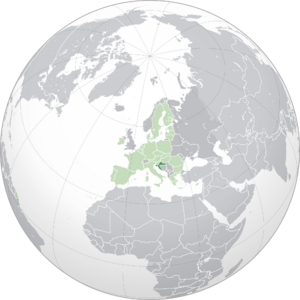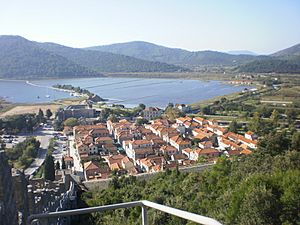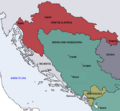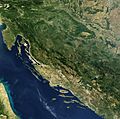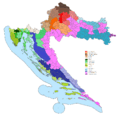Croatia facts for kids
Quick facts for kids
Republic of Croatia
Republika Hrvatska (Croatian)
|
|
|---|---|
|
Anthem: "Lijepa naša domovino"
("Our Beautiful Homeland") |
|
|
Location of Croatia (dark green)
– on the European continent (green & dark grey) |
|
| Capital and largest city
|
Zagreb 45°48′47″N 15°58′39″E / 45.81306°N 15.97750°E |
| Official languages | Croatian |
| Writing system | Latin |
| Ethnic groups
(2021)
|
|
| Religion
(2021)
|
|
| Demonym(s) | |
| Government | Unitary parliamentary republic |
| Zoran Milanović | |
| Andrej Plenković | |
| Gordan Jandroković | |
| Legislature | Sabor |
| Establishment history | |
|
• Duchy
|
7th century |
|
• Kingdom
|
925 |
| 1102 | |
|
• Joined Habsburg Monarchy
|
1 January 1527 |
|
• Secession from
Austria-Hungary |
29 October 1918 |
|
• Creation of Yugoslavia
|
4 December 1918 |
|
• Declaration of independence
|
25 June 1991 |
|
• Joined NATO
|
1 April 2009 |
|
• Joined the European Union
|
1 July 2013 |
| Area | |
|
• Total
|
56,594 km2 (21,851 sq mi) (124th) |
|
• Water (%)
|
1.09 |
| Population | |
|
• 2023 estimate
|
|
|
• 2021 census
|
|
|
• Density
|
68.4/km2 (177.2/sq mi) (152nd) |
| GDP (PPP) | 2024 estimate |
|
• Total
|
|
|
• Per capita
|
|
| GDP (nominal) | 2024 estimate |
|
• Total
|
|
|
• Per capita
|
|
| Gini (2020) | ▼ 28.3 low |
| HDI (2022) | very high · 39th |
| Currency | Euro (€) (EUR) |
| Time zone | UTC+1 (CET) |
|
• Summer (DST)
|
UTC+2 (CEST) |
| Calling code | +385 |
| ISO 3166 code | HR |
| Internet TLD | |
Croatia ( kroh-AY-shə) is a country in Europe. It is located where Central Europe and Southern Europe meet. Its capital and largest city is Zagreb.
Croatia was once part of a country called Yugoslavia. It became an independent country in 1991. On July 1, 2013, Croatia joined the European Union.
Contents
History of Croatia
In ancient times, different groups of people lived in the land that is now Croatia. These included early humans like Neanderthals. Later, Neolithic cultures also lived there.
The Romans arrived and took control of the area in 9 AD. They called it the province of "Dalmatia." Over 400 years, the people there adopted Roman ways of life.
In the early 600s AD, a group of West Slavs called the Croats arrived. Croatia gets its name from them. Christian missionaries soon came and helped the Croats become Roman Catholic Christians.
In 925, Tomislav became the first King of Croatia. Croatia was an independent Catholic kingdom until 1102. Then, a Hungarian prince became the King of Croatia. Hungary ruled Croatia until 1526. After that, Croatia chose the Austrian Archduke Ferdinand as its king.
Croatia remained part of the Austria-Hungary empire until 1918. In 1918, it joined the Kingdom of Slovenians, Croats, and Serbs. This country was later named Yugoslavia.
During World War II, Yugoslavia was taken over. A new state called the Independent State of Croatia was formed in 1941. However, it was controlled by Nazi Germany.
In 1945, Croatia became part of a new Yugoslavia. This Yugoslavia was not allied with any major power blocs. In 1991, Yugoslavia broke apart. Slovenia and then Croatia declared their independence.
Croatia became a democratic country. The changes around 2000 helped Croatia join the European Union. It became a member on July 1, 2013.
In recent years, Croatia has become a very popular place for tourists. Many people visit its coastal areas like Dalmatia and Istria.
Geography of Croatia
Croatia is located in Central Europe and Southeast Europe. It shares borders with several countries. These include Hungary, Serbia, Bosnia and Herzegovina, Montenegro, and Slovenia. The Adriatic Sea is to its southwest.
A small part of Croatia near Dubrovnik is separated from the rest of the country by land. This area is connected by water but cut off on land by a small strip belonging to Bosnia and Herzegovina. Croatia is divided into 21 regions called counties.
Croatia is the 127th largest country in the world. Its highest point is Dinara peak, which is 1,831 meters (6,007 feet) tall. Croatia has thousands of islands. About 48 of these islands have people living on them all year. The biggest islands are Cres and Krk. Major rivers include the Sava, Drava, Kupa, and Danube.
Croatia also has many deep caves. There are 49 caves that are deeper than 250 meters (820 feet). The most famous lakes in Croatia are the Plitvice Lakes.
Climate in Croatia
Most of Croatia has a moderately warm and rainy continental climate. The average temperature in January is about -3°C (27°F). In July, it is around 18°C (64°F). The coldest parts of Croatia are Lika and Gorski Kotar. The warmest areas are along the Adriatic coast.
Nature and Wildlife in Croatia
Croatia has many different ecoregions. Its coastline, forests, mountains, and rivers create a wide variety of flora (plants) and fauna (animals). There are over a thousand endemic species here. This means they are found only in Croatia.
One unique animal found in Croatia is the olm. It is the only known aquatic (water-dwelling) cave animal with a backbone.
Croatia has 444 protected areas of Croatia. These include eight national parks and ten nature parks. The oldest national park is the Plitvice Lakes National Park. It is a UNESCO World Heritage Site.
Government and Politics
Croatia adopted its constitution in 1990. It officially declared independence from Yugoslavia on October 8, 1991.
The President of the Republic is the head of state. The people directly elect the President for a five-year term. A President can serve a maximum of two terms. The Prime Minister of Croatia is the head of government.
Croatia is divided into 21 counties for administrative purposes.
Economy of Croatia
Croatia is one of the more developed countries in the Balkan Peninsula. It also had higher living costs compared to some other countries in Central Europe. The average monthly salary in Croatia is about 739 Euros (nearly US$1000).
The age for retirement is 65 for men and 60 for women. Healthcare in Croatia provides good protection for its citizens.
Education in Croatia
Education in Croatia is free for everyone. It is required for children until they turn 15 years old. Many students choose to continue their studies in high school until they are 18.
Tourism in Croatia
After a period of conflict, Croatia has worked hard to rebuild. It has become a popular place for tourists. People love its clear waters, old medieval cities, and beautiful nature. Croatia combines Western and Eastern styles in its buildings. It also cares about its environment and traditions.
Dubrovnik is a very famous city in Croatia. It is known as one of the most beautiful cities in Europe. Croatia is focusing on sustainable tourism. This means visitors can enjoy the culture, food, and nature while respecting the local way of life.
There are many great reasons to visit Croatia. It has six UNESCO World Heritage sites:
- Dubrovnik's Old Town
- The Diocletian's Palace in Split
- The historic center of Trogir
- The Cathedral of St. James in Sibenik
- The Plitvice Lakes National Park
- The Episcopal Ensemble of the Euphrasian Basilica in Poreč (Istria)
Nature is another big draw for tourists. Croatia has eight National Parks and ten Natural Parks. They have amazing plants and animals. The coastline stretches from the Istria Peninsula to southern Dalmatia. It has many beautiful coves, beaches, and cliffs.
The islands are also very popular. Islands like Hvar and Korcula in Dalmatia, or Rab and Losinj in Kvarner Bay, attract millions of tourists. There are over a thousand islands and islets along the Adriatic Coast. It is a perfect place for people who love sailing.
Croatia offers more than just the famous cities of Dubrovnik, Zagreb, or Split. There is something for everyone to discover.
Related pages
- List of cities in Croatia
- Croatia at the Olympics
- Croatia national football team
- List of rivers of Croatia
Images for kids
-
The 1st century-built Pula Arena was the sixth largest amphitheatre in the Roman Empire
-
Kingdom of Croatia c. 925, during the reign of King Tomislav
-
Coronation of King Tomislav by Oton Iveković
-
Croatian Ban Nikola Šubić Zrinski is honoured as a national hero for his defence of Szigetvár against the Ottoman Empire
-
Ban Josip Jelačić at the opening of the first modern Croatian Parliament (Sabor), June 5, 1848. The tricolour flag can be seen in the background.
-
The Kingdom of Croatia-Slavonia was an autonomous kingdom within Austria-Hungary created in 1868 following the Croatian–Hungarian Settlement.
-
Stjepan Radić, leader of the Croatian Peasant Party who advocated federal organisation of the Yugoslavia, at the assembly in Dubrovnik, 1928
-
German dictator Adolf Hitler with Quisling and dictator of the Independent State of Croatia Ante Pavelić at the Berghof outside Berchtesgaden, Germany
-
Cardinal Aloysius Stepinac with the Croatian communist leader Vladimir Bakarić at the celebration of May Day, shortly before Stepinac was arrested by the Communists and taken to court
-
Josip Broz Tito led SFR Yugoslavia from 1944 to 1980; Pictured: Tito with the US president Richard Nixon in the White House, 1971
-
Bottlenose dolphins are protected under Croatian law with Adriatic Dolphin project as the longest ongoing study of a single resident bottlenose dolphin community in the Mediterranean Sea
-
Wooden trail through nature park Kopački Rit in Osijek-Baranja County
-
Honor guard in the front of Banski Dvori in Zagreb welcoming Pedro Sánchez Prime Minister of Spain and Andrej Plenković Prime Minister.
-
Justices of the Constitutional Court of Croatia in 2009
-
President Zoran Milanović on NATO summit on 24 March 2022. The accession of Croatia to NATO took place in 2009
-
Croatian Air Force and US Navy aircraft participate in multinational training, 2002
-
Varaždin, capital of Croatia between 1767 and 1776, is the seat of Varaždin county; Pictured: Old Town fortress, one of 15 Croatia's sites inscribed on the UNESCO World Heritage tentative list
-
Dubrovnik is one of Croatia's most popular tourist destinations.
-
Pelješac Bridge connects the peninsula of Pelješac and through it the southernmost part including Dubrovnik with the Croatian mainland
-
The Baška tablet is the oldest Glagolitic monument in Croatia. It documents the donation of land gifted by Croatian King Dmitar Zvonimir to the Benedictine monastery of St Lucy
-
University of Zagreb is the largest Croatian university and the oldest university in the area covering Central Europe south of Vienna and all of Southeastern Europe (1669)
-
University Hospital Centre Zagreb is the largest hospital in Croatia and the teaching hospital of the University of Zagreb
-
Historic centre of Trogir has been included in the UNESCO list of World Heritage Site since 1997
-
Euphrasian Basilica in Poreč, example of early Byzantine architecture, on the UNESCO World Heritage List since 1997.
-
Historical nucleus of Split with the 4th-century Diocletian's Palace was inscribed on the UNESCO list of World Heritage Sites in 1979
-
Teran wine from Istria region
-
Croatia national football team came in second at the 2018 World Cup in Russia
See also
 In Spanish: Croacia para niños
In Spanish: Croacia para niños




